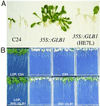Increased level of hemoglobin 1 enhances survival of hypoxic stress and promotes early growth in Arabidopsis thaliana
- PMID: 12486248
- PMCID: PMC139292
- DOI: 10.1073/pnas.212648799
Increased level of hemoglobin 1 enhances survival of hypoxic stress and promotes early growth in Arabidopsis thaliana
Abstract
Overexpression of a class 1 Hb (GLB1) protects Arabidopsis thaliana plants from the effects of severe hypoxia. Overexpression of the bifunctional symbiotic Hb (GLB1S) from Parasponia andersonii in A. thaliana also increases survival after hypoxia. Plants overexpressing the Hb 1 protein, mutated to have a low oxygen affinity, are as susceptible to hypoxia as WT plants, suggesting that the protection against hypoxia depends on the ability of the Hb to bind ligands, such as oxygen, with high affinity. A mild hypoxia pretreatment (5%) induces the Hb gene and increases the survival of plants after severe hypoxic treatment (0.1%). These results with Hb 1 show that plant Hbs have a role other than in nitrogen-fixing root nodules. Plants overexpressing the GLB1 protein show early vigorous growth in nonhypoxic conditions and are 50% larger in weight than the controls at 14 days. The constitutive expression of GLB1 also resulted in a reduced number of root hairs and increased number of laterals in the root system.
Figures




Similar articles
-
Haemoglobin modulates NO emission and hyponasty under hypoxia-related stress in Arabidopsis thaliana.J Exp Bot. 2012 Sep;63(15):5581-91. doi: 10.1093/jxb/ers210. Epub 2012 Aug 21. J Exp Bot. 2012. PMID: 22915746 Free PMC article.
-
Expression of NO scavenging hemoglobin is involved in the timing of bolting in Arabidopsis thaliana.Planta. 2008 Mar;227(4):917-27. doi: 10.1007/s00425-007-0667-z. Epub 2007 Nov 22. Planta. 2008. PMID: 18034356
-
Overexpressing the ANR1 MADS-box gene in transgenic plants provides new insights into its role in the nitrate regulation of root development.Plant Cell Physiol. 2012 Jun;53(6):1003-16. doi: 10.1093/pcp/pcs050. Epub 2012 Apr 19. Plant Cell Physiol. 2012. PMID: 22523192
-
Plant hemoglobins: what we know six decades after their discovery.Gene. 2007 Aug 15;398(1-2):78-85. doi: 10.1016/j.gene.2007.01.035. Epub 2007 Apr 25. Gene. 2007. PMID: 17540516 Review.
-
Nonsymbiotic hemoglobins and stress tolerance in plants.Plant Sci. 2009 Apr;176(4):433-40. doi: 10.1016/j.plantsci.2009.01.003. Epub 2009 Jan 20. Plant Sci. 2009. PMID: 26493132 Review.
Cited by
-
Phytoglobins Improve Hypoxic Root Growth by Alleviating Apical Meristem Cell Death.Plant Physiol. 2016 Nov;172(3):2044-2056. doi: 10.1104/pp.16.01150. Epub 2016 Oct 4. Plant Physiol. 2016. PMID: 27702845 Free PMC article.
-
Cellular localization of the Arabidopsis class 2 phytoglobin influences somatic embryogenesis.J Exp Bot. 2017 Feb 1;68(5):1013-1023. doi: 10.1093/jxb/erx003. J Exp Bot. 2017. PMID: 28199692 Free PMC article.
-
The inhibition of maize (Zea mays L.) root stem cell regeneration by low oxygen is attenuated by Phytoglobin 1 (Pgb1) through changes in auxin and jasmonic acid.Planta. 2023 May 13;257(6):120. doi: 10.1007/s00425-023-04144-w. Planta. 2023. PMID: 37178357
-
Expression of Arabidopsis class 1 phytoglobin (AtPgb1) delays death and degradation of the root apical meristem during severe PEG-induced water deficit.J Exp Bot. 2017 Nov 28;68(20):5653-5668. doi: 10.1093/jxb/erx371. J Exp Bot. 2017. PMID: 29059380 Free PMC article.
-
Signaling from an altered cell wall to the nucleus mediates sugar-responsive growth and development in Arabidopsis thaliana.Plant Cell. 2007 Aug;19(8):2500-15. doi: 10.1105/tpc.106.049965. Epub 2007 Aug 10. Plant Cell. 2007. PMID: 17693536 Free PMC article.
References
-
- Blaxter M. L. (1993) Parasitol. Today 9, 353-360. - PubMed
-
- Doyle J. J. (1998) Trends Plant Sci. 3, 473-478.
-
- Hunt P. W., Watts, R. A., Trevaskis, B., Llewellyn, D. J., Burnell, J., Dennis, E. S. & Peacock, W. J. (2001) Plant Mol. Biol. 47, 677-692. - PubMed
-
- Burr A. H. J., Hunt, P., Wagar, D. R., Dewilde, S., Blaxter, M. L., Vanfleteren, J. R. & Moens, L. (2000) J. Biol. Chem. 275, 4810-4815. - PubMed
-
- Burmester T., Weich, B., Reinhardt, S. & Hankeln, T. (2000) Nature 407, 520-523. - PubMed
MeSH terms
Substances
LinkOut - more resources
Full Text Sources
Other Literature Sources
Molecular Biology Databases

